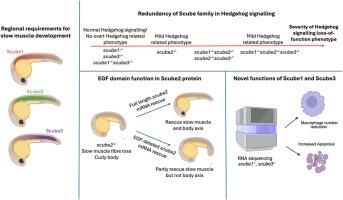Redundant and novel functions of scube genes during zebrafish development
IF 2.1
3区 生物学
Q2 DEVELOPMENTAL BIOLOGY
引用次数: 0
Abstract
The N-glycoprotein SCUBE family (Scube1, Scube2, and Scube3) plays diverse roles in vertebrate development and disease, yet many specific functions of the three family members remain unclear. These proteins exhibit broad tissue expression patterns, exist as soluble or membrane-tethered forms, and can form homo- or heteromeric complexes with each other, exerting both short- and long-range effects. Individual functional characterisation has proved challenging because of overlapping expression patterns and compensatory mechanisms that likely obscure specific roles. To elucidate Scube function, we generated single, double, and triple mutant combinations of the three scube genes in zebrafish and assessed their roles in Hedgehog signalling. Our findings indicate that all three Scube proteins contribute to muscle development at distinct levels, with triple knockout zebrafish larvae displaying near-complete Hedgehog loss-of-function phenotypes. RNA sequencing analysis revealed potential roles for all three scube genes, and specific functions for Scube1 and Scube3 in apoptosis regulation and macrophage biology were identified. Furthermore, the Scube family contains multiple functional domains, and the role of EGF domains in Hedgehog signalling remains contentious. Comparative rescue analysis revealed that full-length scube2 mRNA restored slow muscle fibre numbers more efficiently than EGF domain-truncated constructs in scube2 knockout zebrafish, demonstrating the importance of EGF domains in Scube2 function. Our results illustrate both redundant and non-redundant functions among Scube family members and provide new insights into the roles of this enigmatic class of developmental regulators.

斑马鱼发育过程中scube基因的冗余和新功能。
n -糖蛋白SCUBE家族(Scube1、Scube2和Scube3)在脊椎动物的发育和疾病中发挥着多种作用,但这三个家族成员的许多具体功能尚不清楚。这些蛋白表现出广泛的组织表达模式,以可溶性或膜系结形式存在,并且可以相互形成同质或异质复合物,发挥短期和长期的作用。个体功能特征证明具有挑战性,因为重叠的表达模式和补偿机制可能模糊了特定的作用。为了阐明Scube的功能,我们在斑马鱼中生成了三种Scube基因的单、双和三重突变组合,并评估了它们在Hedgehog信号传导中的作用。我们的研究结果表明,所有三种Scube蛋白都在不同水平上促进肌肉发育,三敲除斑马鱼幼虫表现出近乎完全的Hedgehog功能丧失表型。RNA测序分析揭示了这三个sccube基因的潜在作用,并鉴定了Scube1和Scube3在细胞凋亡调控和巨噬细胞群体中的功能。此外,sccube家族包含多个功能结构域,EGF结构域在Hedgehog信号传导中的作用仍然存在争议。对比挽救分析显示,在scube2基因敲除的斑马鱼中,全长scube2 mRNA比EGF结构域截断的构建体更有效地恢复了缓慢的肌纤维数量,这表明EGF结构域对scube2功能的重要性。我们的研究结果说明了sccube家族成员之间的冗余和非冗余功能,并为这类神秘的发育调节因子的作用提供了新的见解。
本文章由计算机程序翻译,如有差异,请以英文原文为准。
求助全文
约1分钟内获得全文
求助全文
来源期刊

Developmental biology
生物-发育生物学
CiteScore
5.30
自引率
3.70%
发文量
182
审稿时长
1.5 months
期刊介绍:
Developmental Biology (DB) publishes original research on mechanisms of development, differentiation, and growth in animals and plants at the molecular, cellular, genetic and evolutionary levels. Areas of particular emphasis include transcriptional control mechanisms, embryonic patterning, cell-cell interactions, growth factors and signal transduction, and regulatory hierarchies in developing plants and animals.
 求助内容:
求助内容: 应助结果提醒方式:
应助结果提醒方式:


